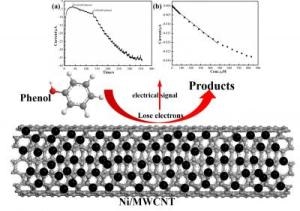Dec 12 2018
Scientists at the Harbin Institute of Technology have discovered a non-enzymatic and low-cost phenol sensor that has good selectivity, high sensitivity, stability, and reproducibility. Reported in NANO, the latest study holds promising applications in the detection of phenols in discharged wastewater.
 (Image credit: Zhongping Yao/Harbin Institute of Technology)
(Image credit: Zhongping Yao/Harbin Institute of Technology)
As one of the wayward organic contaminants, phenol is universally present in wastewater. From the viewpoint of regulating environmental pollutants, it is desirable and meaningful to track and regulate phenol pollutant.
Electrochemical sensor has unique advantages like low cost, portability, real-time monitoring, fast response, low maintenance, and convenience of handling. Therefore, electrochemical sensor for phenol detection presents an alternative method that holds promising applications. Within the electrochemical sensor, the electrode material played a central role in improving phenol-sensing performance by raising the phenol’s electron-oxidation current.
As a result, a suitable electrode material with good selectivity, high sensitivity, and stability must be screened out for electrochemical detection of phenol. Ni—the transitional metal—has broad applications in electrocatalyzing organic substances because of its abundant reserves and excellent catalytic activity. Yet, Ni nanoparticle tends to aggregate owing to its large specific surface energy, resulting in decreased active sites and also decreased loss of catalytic activity.
Multi-walled carbon nanotube, or MWCNT, with special 1D structure and exceptional mechanical and electrical characteristics can be applied as scaffold to anchor Ni nanoparticle for preventing the aggregation of the Ni nanoparticle, and also for improving the rate of electron transfer, thereby enhancing phenol-sensing performance. This new, Ni/MWCNT-based electrochemical sensor could be used for detecting phenols in discharged wastewater.
The team at the Harbin Institute of Technology is now leveraging new approaches to further enhance phenol-sensing performance, for example, widening detection range, lowering detection limit, and improving sensitivity, while reducing cost in the meantime.
Other co-authors of the paper are Yajing Wang, Jiankang Wang, Chenyu Liu, Taiping Xie, Qihuang Deng, and Zhaohua Jiang.
The study was financially supported by the National Natural Science Foundation of China (No. 51571076), Open Project of State Key Laboratory of Urban Water Resource and Environment of Harbin Institute of Technology (No. HCK201716).
Zhongping Yao is the corresponding author of the study published in NANO.